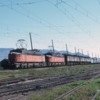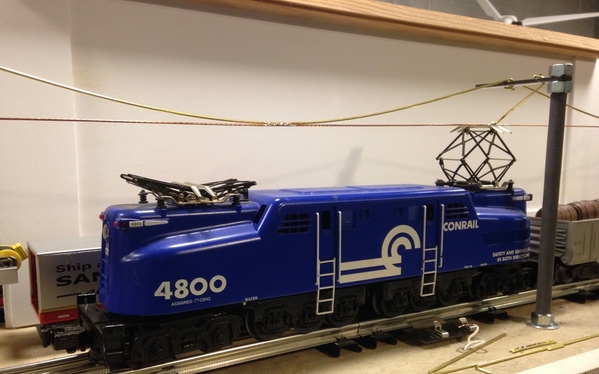Running GG1s under nothing but the sky was just not cutting it. I am building a crude system, for now, with plans to enhance it as time allows.
Replies sorted oldest to newest
Looks like your off to a good start.
Dave
I love it.
I always wondered when its on and you touch it , will it shock you, cause its center rail?
What voltage are you running?
Your simple system is prototypical. Way back when, the Milwaukee Road electrified Western Route looked just like your setup, except that they didn't run GG1's. As you know that engine was unique to the Pennsylvania RR and later NJT and Conrail.
Jushavnfun posted:I love it.
I always wondered when its on and you touch it , will it shock you, cause its center rail?
What voltage are you running?
I plan to make it live. No, it won't cause any pain if you touch it. That is unless you happen to have an open cut somewhere on your hands or arms. It happened to me once. I was working on my layout and an open cut hit the center and outside rail. Not quite as shocking as 110 volts but startling just the same.
I'm running standard voltage for our trains, 0-20 volts.
Dennis LaGrua posted:Your simple system is prototypical. Way back when, the Milwaukee Road electrified Western Route looked just like your setup, except that they didn't run GG1's. As you know that engine was unique to the Pennsylvania RR and later NJT and Conrail.
Yes, the Milwaukee system was child's play compared to the Pennsy's catenary system. In many places the MR simply used wood poles. The Milwaukee Road had their own unique variety of locomotives. A pity they abandoned overhead power in the seventies.
Attachments
Thanks for sharing Dan! The "simple" system you have now is quite elegant, far from crude. ![]()
Dan, the catenary you are building looks good, I worked for NICTD in Northwest Indiana and their catenary system is similar to your design. I was considering the construction of a catenary system and would use this same design. Keep up the construction you may need to add inclined struts mounted off the poles in the curves to keep the catenary within track gauge for pantograph contact. If my memory is correct the upper (trolley) has the parabolic bow, the bottom(messenger) wire is level and makes the contact with the pantograph, the hangers that support the messenger from trolley wire vary in length because of the quasi- parabolic shape.
Very nice Dan, can you tell us what materials you are using, and maybe a close up image?
Very cool, looks like it will just be a matter of time for your empire to be "overhead electrified". Keep the pictures coming as changes occur, very enjoyable
I just remembered who it was that gave me the idea to build a catenary system using bolt rod and flat plates, Pantenary, one of our forum members. I was so inspired by his work and thought how simple yet robust.
Good evening Mr. Padova:
Welcome, welcome BACK to the dark side of the tracks. ![]()
--NMM
So tonight I did some alterations to the part of the catenary that is visible. It's a twelve foot stretch along the front of the layout. I wasn't happy with the individual sections I had previously. My brainstorm is that I stretched a piece of copper ground wire, the type you might see on a chandelier. It's bare copper twisted wire about sixteen or eighteen gauge. On one end I have a turnbuckle that keeps the wire taught. Then, using the 1/16" diameter brass rod, I created the catenary support wire.
This system is more durable and much straighter. I does not have the many hangers that a catenary system usually has, but it is in keeping with my KISS system.
The poles are 3/8" diameter bolt rod covered with heat shrink tubing. The lateral beams are 1/8" x 1/2" aluminum stock.
Attachments
Looks good Dan. Are you going to power it eventually?
Dan,
Nothing crude about your system. It looks and works fine. I am also in the process of building a live catenary system. It is a lot of work but worth the effort.
Ed
The catenary poles look good, and they certainly appear to be quite sturdy. And the heat shrink was near perfect for a covering. Your soldering looks really good - I imagine it was extra tricky since some/all? of the connections were under tension?
Do all your GG-1s and other powered engines have the same height from the top of the rail to the maximum extension of the pantographs?
George
RSJB18 posted:Looks good Dan. Are you going to power it eventually?
That's my next step.
GeoPeg posted:The catenary poles look good, and they certainly appear to be quite sturdy. And the heat shrink was near perfect for a covering. Your soldering looks really good - I imagine it was extra tricky since some/all? of the connections were under tension?
Do all your GG-1s and other powered engines have the same height from the top of the rail to the maximum extension of the pantographs?
George
The GG1 and EP-5s are both comfortable under my catenary contact wire height of just under 6", measured from the table to the wire. E-33 Rectifiers not so. And if I raise the wire to make the E-33s happy, the GG1s and EP-5s don't make contact.
I discovered this back in the '80s, the last time I had operating catenary.
Dan,
What materials did you use?
Sorry. Just read post. Ignor.

















